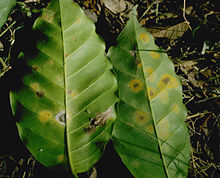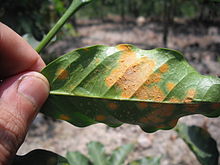- Hemileia vastatrix
-
Hemileia vastatrix 
Symptoms of coffee rust caused by Hemileia vastatrix on foliage Scientific classification Kingdom: Fungi Division: Basidiomycota Class: Pucciniomycetes Order: Pucciniales Genus: Hemileia Species: H. vastatrix Binomial name Hemileia vastatrix
Berk. & Broome (1869)Synonyms Wardia vastatrix J.F.Hennen & M.M.Hennen (2003)
Hemileia vastatrix is a fungus of the order Uredinales that causes coffee rust, a disease that is devastating to coffee plantations. Coffee serves as the obligate host of coffee rust, that is, the rust must have access to and come into physical contact with coffee (Coffea arabica) in order to survive.
Contents
Morphology
The mycelium with uredinia looks yellow-orange and powdery, and appears on the underside of leaves as points ~0.1 mm in diameter. Young lesions appear as chlorotic or pale yellow spots some millimetres in diameter, the older being a few centimetres in diameter. Hyphae are club-shaped with tips bearing numerous pedicels on which clusters of urediniospores are produced.
Telia are pale yellowish, teliospores often produced in uredinia; teliospores more or less spherical to limoniform, 26–40 × 20–30 µm in diameter, wall hyaline to yellowish, smooth, 1 µm thick, thicker at the apex, pedicel hyaline.
Urediniospores are more or less reniform, 26–40 × 18-28 µm, with hyaline to pale yellowish wall, 1–2 µm thick, strongly warted on the convex side, smooth on the straight or concave side, warts frequently longer (3–7 µm) on spore edges.
Spermogonia and aecia are unknown.
Life-cycle
Hemileia life-cycle begins with the germination of uredospores through germ pores in the spore. It mainly attacks the leaves and is only rarely found on young stems and fruit. Appressoria are produced which in turn produce vesicles from which entry into the substomatal cavity is gained. Within 24–48 hours, infection is completed. After successful infection, the stomatal cavity is colonized and sporulation will occur. One lesion produces 4–6 spore crops over a 3–5 month period releasing 300–400,000 spores.
Probably it does not complete its life-cycle on Coffee tree, but lives on some stage on some other, as yet unknown plant (heteroecious life-cycle).
Ecology
Hemileia vastatrix is an obligate parasite, that lives mainly on the plants of genus Coffea, reportedly also on Gardenia in South Africa. It needs suitable temperatures to develop (not less than 10°C and not greater than 35°C). The presence of free water is required for infection to be completed. Loss of moisture after germination has been initiated inhibits the whole infection process.
Sporulation is most influenced by temperature, humidity, and host resistance. The colonization process is not dependent on leaf wetness, but is influenced greatly by temperature and by plant resistance. The main effect of temperature is to determine the length of time for the colonization process (incubation period).
Hemileia vastatrix has two fungal parasites, Verticillium haemiliae and Verticillium psalliotae.
The fungus is probably of East African origin, but nowadays widely spread in Africa, tropical Asia, Middle- and South-America. Uredospores are disseminated to long distances mainly by wind, and over short distances by both wind and rain. Other agents such as animals, mainly insects and man, occasionally have been shown to be involved with dissemination.
Disease reports
Historically found in coffee-growing areas of Africa, the Near East, India, Asia, and Australia, the disease was discovered in 1970 to be widespread in Brazil, marking the first known spread to the Western Hemisphere. Hence it is now found worldwide in virtually all coffee-producing countries.[1]
The disease was first reported in Kenya in 1861. By 1869 it had spread to Sri Lanka, and by the 1920s it was widely found across much of Africa and Asia. In the last decades of the nineteenth century, coffee rust did serious damage to the coffee plantations of Sri Lanka, Philippines, Java and Malaya,which led to the collapse of the coffee industry in Lipa, Batangas and almost putting the extinction of the Arabica variety. This led to increased cultivation of alternative crops, notably tea in Sri Lanka, and rubber in all three places. Liberica, a species cultivated in the Philippines since early in the 19th Century, was found to be resistant and thus rose to prominence in Philippine coffee production by the mid-20th Century. Liberica coffee grown in Batangas is locally known as "Barako" coffee, named after the laborers who worked harvesting and processing the coffee.
Use as an herbicide
Coffee Rust was used by the USA in Guatemala as a herbicide in 1950. [2]
References
- ^ Waller JM, Bigger M, Hillocks RJ (2007). Coffee pests, diseases and their management. Wallingford, Oxfordshire: CABI. p. 171. ISBN 1845931297.
- ^ Suffert, Frédéric; Émilie Latxague and Ivan Sache (11 March 2009). "Plant pathogens as agroterrorist weapons: assessment of the threat for European agriculture and forestry". Food Security (Springer Netherlands) 1 (2): 221–232. doi:10.1007/s12571-009-0014-2. http://www.springerlink.com/content/jw473qk022660161/. Retrieved 14 May 2009.
- Coffee Research Institute: Coffee rust
- University of Nebraska-Lincoln: Coffee rust
- The University of Hawaii page on Hemileia vastatrix [1]
- U.S.Dept.Agriculture page on Coffee Leaf Rust[2]
External links
Categories:- Teliomycotina
- Coffee diseases
- Fungi described in 1869
- Fungi of Africa
- Fungi of Asia
- Fungi of South America
Wikimedia Foundation. 2010.

